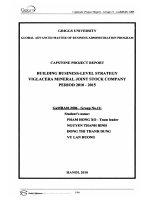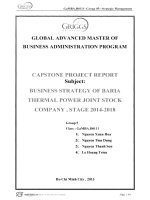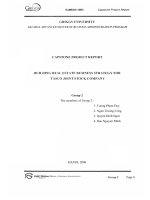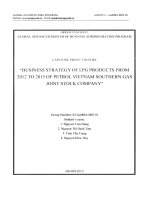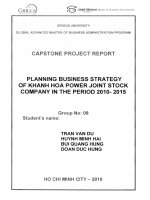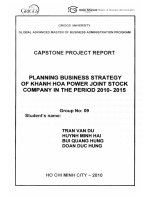Low organizational commitment at unitrade joint stock company
Bạn đang xem bản rút gọn của tài liệu. Xem và tải ngay bản đầy đủ của tài liệu tại đây (304.38 KB, 70 trang )
UNIVERSITY OF ECONOMICS HO CHI MINH CITY
International School of Business
------------------------------
Nguyen Huynh Hoai Binh
LOW ORGANIZATIONAL COMMITMENT AT
UNITRADE JOINT STOCK COMPANY
MASTER OF BUSINESS ADMINISTRATION
Ho Chi Minh City – 2016
UNIVERSITY OF ECONOMICS HO CHI MINH CITY
International School of Business
------------------------------
Nguyen Huynh Hoai Binh
LOW ORGANIZATIONAL COMMITMENT AT
UNITRADE JOINT STOCK COMPANY
ID: 22 12 00 04
MASTER OF BUSINESS ADMINISTRATION
Supervisor: Le Nhat Hanh
Ho Chi Minh City – 2016
2
Table of Contents
Executive Summary ......................................................................................................................................
Chapter 1: Problem Identification .................................................................................................................
1.1
Company background ...............................................
1.2
Background of problem .............................................
1.2.1
Symptoms ...................................................................
1.2.2
Possible problems ........................................................
1.3
Problem Justification .................................................
1.3.1
Problem definition....................................................
1.3.2
Justify the existence of the problem .......................
1.3.3
Justify the importance of the problem ...................
High Turnover Rate ............................................................................................................................
Ineffective Performance of Employees ...............................................................................................
Employee Absenteeism .......................................................................................................................
1.4 Potential causes of the problem ........................................................................................................
1.4.1
Organizational Policies ...............................................
1.4.2
Compensation & Benefits ...........................................
1.4.3
Job satisfaction ............................................................
1.4.4
Supervisory Support ....................................................
1.4.5
Working environment ..................................................
1.4.6
Training and career development ................................
Initial Causes And Effect Map ............................................................................................................
1.5 Causes validation .............................................................................................................................
1.5.1
Training and career development ................................
1.5.2
Organizational policies & Compensation ....................
1.5.3
Working environment & Supervisory Support ............
1.5.4
Job Satisfaction ...........................................................
2.1 Alternative Solutions ........................................................................................................................
2.1.1
Dismissal and Recruitment .........................................
2.1.2
Team Building .............................................................
2.1.3
Workplace Training .....................................................
3
2.2 Solution Comparison..................................................................................................................31
2.3 Recommendations.....................................................................................................................33
Chapter 3: Action Plan.........................................................................................................................35
Conclusion...........................................................................................................................................42
Supporting Information.................................................................................................................................43
Appendix 1: Survey questionnaire of problem existence:........................................................................43
Appendix 2: Results of survey questionnaire of problem existence:.......................................................45
Appendix 3: Open questions for problem existence.................................................................................46
Appendix 4: Interview transcript for problem existence..........................................................................47
Appendix 5: Survey questionnaire of problem potential causes:.............................................................51
Appendix 6: Open questions for the causes of the problem:....................................................................54
Appendix 7: Focus group data on causes justification and recommendations.........................................55
Appendix 9: Detailed Implementation Plan..............................................................................................58
REFERENCES..............................................................................................................................................59
4
LIST OF TABLE
Table 1: The overall Turnover rate in year 2013 and 2014……………………………….14
Table 2: Initial causes and effect map……………………………………………………..23
Table 3: The comparison between solutions: training, teamwork and recruitment……….32
Table 4: The action timeline and objects for the project………………………………….35
Table 5: The cost and budget for the solution…………………………………………….40
5
ACKNOWLEDMENT
I would like to extend the warmest thanks and debt of gratitude to the
following people who have truly made vital contribution to the completion of this
dissertation. Indeed, without them I definitely would not have written this paper.
Firstly, I would like to express my truthful thanks to my advisor, Ms. Le Nhat
Hanh for her kindly guidance and deeply encouragement from the beginning to the
ending.
Secondly, special thanks to Ms. My Anh, Ms. Tran Lan, Ms. Anh Van, Ms. Thanh
Huynh, Mr. Thu Nguyen for their valuable and precisely information during the
information collection period and in-depth interviews at the Unitrade Company.
Last but not least, big thank you to all of my family’s members and my close
friends who made precious contributions. I hope to receive more support from all of
them in the future.
6
Executive Summary
Unitrade is one of leading companies supplying environment processing
equipments in the entire Vietnam. However, in a high competitive market and due to
economic crisis, nowadays Unitrade had to face to some serious problems. According to
the recent report of the company, a large number of sales staff of the Company is laid off
and if this lasts for long, it will affect development strategies and cause big losses for the
company in the long term. Hence this thesis studies the issue of low commitment of
employees with the company at Unitrade; this issue has recently become more serious
because of its large role in competitive advantage among companies. So, this project will
seek for an appropriate solution based on the literature and the actual situation in the
Company to resolve the ongoing problems. After collecting data, studying theoretical
sources, the author have identified the main cause of problems is lacking of training and
career development program. Data from these interviews has helped the author propose
03 appropriate solutions to solve the above problem: Training program, dismissal and
recruitment and building team work . Through the analysis and evaluation phase, a most
effective solution is training program would be selected to assist the enterprise to
overcome the problem of human loss.
7
Chapter 1: Problem Identification
1.1 Company background
Unitrade Joint Stock Company was established in 2000, operates mainly in the area of
supplying medical and environment processing equipment. Since 2005, the company has
become the exclusive partner of Chi Sun, Shinmaya and Graatech to supply its products
in Vietnam. Their customers are various ranging from universities, research institutes,
physiochemical laboratories to hospitals, manufacturing firms, restaurants, hotels, and
civil works. We also consult and offer European brand-new products to customers.
Performance of after-sales services includes: instructions for use, package installation,
equipment guarantee and maintenance. These services are implemented with assistances
of the firms from accessories supply, technical advice, specialistic training to complex
installation together with foreign experts. The company is operated according to ability
and qualification of experienced staff, who are approached to modern technologies from
many developed countries. Their mission is to bring high quality units and professional
services of technical supports. Over the past 15 years of operation and development,
Unitrade has become one of leading companies supplying environment processing
equipments in the entire Vietnam. Unitrade with its head office located in Ho Chi Minh
City has developed strongly workforce with more than 40 staffs and 3 members of Board
of Directors (BOD). Their products are widely distributed to almost all provinces of
VietNam.
8
1.2 Background of problem
1.2.1 Symptoms
Nowadays, high competitive market and high inflation which led to a significant
VND depreciation. Prices have been soaring and inflation is getting worse, at the same
time, the stock exchange is going down, causing a negative effect on consumer
purchasing power. So it had caused quite a great deal of difficulty in searching for new
customers which then made the sales goal targeted by the company at the end of 2014
unaccomplished. In addition, the real estate market totally frozen in 2004 which has
significantly increased bad debt ratio of banks. Since borrowing from banks got more
difficult, Unitrade had to cut down operation cost and readjust the personnel which have
decreased greatly the revenues of the company since the end of 2004. Hence, the
company had to seek for appropriate approach to continue its operation and carry out
some cut-down policies such as Top sales of the year, reducing rates of salary increase,
holiday leaving policy, etc. which affected directly a large party of the company staff,
especially Sales department. Under that bad circumstance, the number of staff quitting
job increased dramatically. These staffs were prone to leave and seek for better
opportunities in other companies rather than staying and resolving remained problems
together with the company during the tough time.
1.2.2 Possible problems
The brief interview with Mr Minh Do, Sales supervisor, revealed that there might
be some possible causes that leads to the aforementioned symptoms.
9
The first tentative problem is the prolonged economic crisis has made companies
affected. Unitrade also faced many important issues such as reducing profits and
difficulty in finding new customers. Economic crisis has taken the bad effect on domestic
market. As the result, the buying power decreased. Besides, due to the freezing of real
estate and the stock market as the business lasted very careful in spending. According to
Ms. Thanh Nguyen – Business manager: Because of the increase in bad debt ratio, banks
tightened lending policies. In addition, companies met many difficulties in raising capital
because of the high borrowing interest rate. With the current economic situation, not only
the finding new customers but also the maintaining of the loyal customers are the big
challenge for Unitrate.
The second tentative problem is the competitive rate among companies in the same
industry is very high. According to Ms. Huong Le – Sales Department, in the market,
many companies have large capital, they can storage a large number of product, and as a
result, their price is always cheaper than general price. In addition, many foreign
companies began investing in Vietnam with the strength of the good quality and diversity
of products, after sales service and maintenance are also much more professional than
domestic companies, thus providing customers have more choice . Unitrade, has been
struggling in finding potential customers. These competitors have made Unitrade
improve service quality and product diversification, and investing more on the after-sales
service and customer care.
The third tentative problem is difficulties in human resources. Sales team is a very
important force in the company, which is one of the main factors contributing to the
10
success or failure of the enterprise. According to data reported by the HR department, the
proportion of staff quit in 2013, 2014, 2015, respectively 8%, 21% and 27%. The
company's leaders were really worried because if this situation extended, it will led to
incalculable dangers for companies. In addition, through the interview, Board of
Directors of Unitrade said they received a lot of complaints about the attitude of the
staffs, the staffs seem to not really care about their jobs. That made the work delayed and
resultant revenue was not as expected. On the side of the staffs, it has been disclosed that
the remuneration policy of the company is not really fair; the management board needs to
listen to the opinions of employees. Employees in the company feel unmotivated and
have no excitement in working. That is the cause of the high drop-out rates as recently.
Thus it is very difficult for the company to keep the loyalty of employees and as a
consequence the profit from the business of the company was very low. Since the above
symptom is not good for the company in the long term. It is necessary to looking for the
underneath problem that causes those bad condition of the company. According to the
literature review, that phenomenon might reflect the low level commitment of employees
at Unitrade.
Overall, in the past 2 years, Unitrade is facing 3 major problems: Affect from the
economic crisis, the rate of competing with higher rival companies, and problems related
to the employee's loyalty when experienced employees leave company increased. In
which, the first two issues are outside the ability to solve of the company. So based on the
orientation of the company, in 2016 the company should focus on improving the human
resources .
11
Due to the limitations of time, cost and accountability, low commitment of
employees with the company was chosen as the main issue of this essay. Solving this
problem will not only reduce the incidence of staff quit, but also promote work
motivation of employees, management support to overcome current difficulties and
continue to grow the company.
1.3 Problem Justification
1.3.1 Problem definition
Organizational commitment has been defined by Mowday, Porter, and Steers (2013) :
“an identification with the goal’s and values of the organization, a desire to belong to
the organization and a willingness to display effort on behalf of the organization”.
According to Meyer, Stanley, Herscovitch, and Topolnytsky (2002) commitment has
three components including affective commitment (i.e., individuals want to be
attached to the organization, because they fell their goals and values are similar with
the organization); continuance commitment (i.e.,individuals feel they need to be
attached to the organization, because they aware the cost associated with leaving the
organization); and normative commitment (i.e., individuals feel they ought to remain
with the organization, which is guided by sense of duty, obligation and loyalty toward
the organization). Differentiating from engagement, organizational commitment
refers to a person’s attitude and attachment towards their organization (Saks, 2006).
In addition, the commitment related literature by Porter et al (1979) implies that
employee performance and job satisfaction are intensely interrelated to the
satisfaction of employee needs in term of economic and non-economic.
12
1.3.2 Justify the existence of the problem
In order to measure the staff’s commitment to the company, I adopted the scale to
measure commitment from Mowday et al (1979) for interviewing 10 staffs and 30
questionnaires were sent out. Questions were designed to ask for the staff’s opinions
about their job, commitment to the company; future career orientation, motivations of
development, and the detailed questionnaires and questions of the interviews were
attached in the appendix.
The questionnaire comprised of 24 questions and 8 multiple questions for affective
commitment, 8 multiple questions for continuance commitment and 8 multiple questions
for normative commitment. All questions was scored on the 5 point rating scale ranging
from 1 (not agree) to 5 ( totally agree) the average result was 2.1. Meanwhile, when I
conducted the interview with 30 questionnaires from Nhat Anh Company, the direct
competitor with Unitrade, the average result was 3.9 which indicated the alarming low
commitment of the Unitrade staffs. It means the staffs were not really interested in their
job and performed the job at the minimal level, avoiding extra working as best as
possible. Besides, the interview was conducted to hear the staff’s thoughts and feelings
about the company. Most of them were tired of work pressure, unsatisfied with
remuneration policies, and working environment of the company, as well as lacked of
motivations to develop in career. Nine out of ten interviewees reported that they would
quit their job upon encountering a better job opportunity. The outcome of the interview
13
determined the remained issue of the company recently : low level of commitment at
Unitrade Joint Stock Company.
1.3.3 Justify the importance of the problem
The low level of organizational commitment has an negative effect on the performance
of employee and the productivity of the company. The following section is to identify
the importance of the existing problem at Unitrade.
High Turnover Rate
Turn over refers to the cessation of membership in an organization by an individual
who received monetary compensation from that organization. Turnover is often
categorized as voluntary or involuntary. Voluntary turnover is turnover initiated by the
employee such as quitting or resigning. Involuntary turnover is initiated by the
organization or by circumstances which were beyond the control of either the employee
or the organization. Involuntary turnover includes dismissal, layoff, retirement, disability
and death (Rose,1991).
Shuck and Wollard (2010) stated that the lower level of employee engagement was
more likely to report the higher level of intention to turnover. In addition, Carmeli and
Weisberg (2006) claimed that the turnover is the consider of an individual about the
probability that they will quit their organization in the near future. In Unitrade in 2014
and a half of 2015, the turnover rate was over 21%, while that of 2013 was only 8%. In
fact, this number is considers as a high turnover ratio for a environmental equipment
supplier in Vietnam since the average turnover ratio in 2014 is approximately 10%.
14
Year
Total of Employees
Compulsory Leave
Voluntary Leave
Turnover Rate
(Source Unitrade JSC)
The turnover rate of sales department occupied for nearly 50% of the total. Sales
Department is an important department in the company because they are the main sources
to bring back the revenue for the company. The results of the mini interview indicated
that more than 60% of Sales staff were not satisfied with the remuneration of the
company.
Ineffective Performance of Employees
Borman & Motowidlo (1993) defined that job performance is the aggregated value
that employee concentrate both directly and indirectly to organizational goals. Mone &
London (2010) suggest that upon improving performance management, organizations can
create and sustain high levels of employee engagement, and thereby higher levels of
performance. According to Anitha (2014): “ employee performance indicates the
financial or non-financial outcome of employee”. In addition, Macey (2009) stated that it
is often recognized that commitment is predictive of employee outcomes, success and
financial performance of organizations.
15
Head of Sales Department of Unitrade emphasized that recently the performance
quality has decreased dramatically. Her staffs frequently submitted unsatisfactory reports
and she had to spend time on checking and modifying before such reports reached
customers’ hands. In addition, the staffs usually handled their job at a slow progress
resulting in the increasing overdue projects. Previously, the company did not get many
complaints from customers. Nevertheless, according to a statistics of the company, in
2014 the complaints from customers rose by 39% comparing to that of 2013. The
complaints were mainly about the attitudes and working manner of the sales staffs.
Moreover, she also found that the number of staff distracting from their job was
increasing. A significant part of the staff, especially those being new employees usually
spent working time on personal matters such as surfing the Internet, and logging on social
pages, or reading online publications while others shopping online. Once having free
time, her staffs usually chit-chatted about personal matters of life instead searching for
knowledge, improving necessary skills in work, or learning about experiences in dealing
with customers from each other. According to the statistics of IT Department, more than
65% of the company staff spent one to two hours a day on the Internet and personal
matters. This led to the worryingly decreased work performance.
Employee Absenteeism
Voluntary absenteeism is pervasive across organizations, its costs to organizations
are exorbitant ( Steers & Rhodes,1984). Absenteeism appears very simple on the surface
but is actually a very complex area of study. There is consensus among researchers that
16
there are two types of absenteeism: involuntary and voluntary ( Landau,1981). Herzberg
(1993) suggested that absenteeism was a precursor to turnover. Hill and Trist (1955)
found that absenteeism was an alternative form of withdrawal behavior.
Hackett and Guion (1985) suggested that voluntary absenteeism implied volition, or
an individual’s making a conscious choice whether to attend work on any given day. They
found that one’s decision to be absent from work may result from consideration of the
costs and benefits of missing work on any given day. Steer & Rhodes (1978) found that
the expectancy-based issue was the key to understanding voluntary absenteeism. And
Fichman (1988) stated that people may have attitudes about absenteeism and that
absenteeism may reflect a choice to pursue activities with greater subjective utility
outside the workplace.
In Unitrade, in accordance with the report of HR Department, over the past one
year, the number of staffs going to work late or applying for leave due to personal reasons
has increased greatly. Especially, the figure reached 65% and 73% respectively in May
and June of 2015. Although staffs of HR Department made frequent reminds via email,
the situation was not improved. The Department also proposed some solutions to
improving the situation.
In summary, it is proposed that low level of organizational commitment at Unitrade
is related to three major organizational outcomes: high level of turnover intention, low
employee performance and employee absenteeism. Hence, keeping sustainable
development and advancing the quality are the overall goals of the company. In order to
accomplish those goals, the commitment of the staff to the company must be enhanced.
17
Therefore, to develop the company outcome and productivity as well as completed the
next 5 years strategy, it is necessary to increase the commitment of employees.
1.4 Potential causes of the problem
Based on the review of literature, there are numerous factors that would causes the
problem, the factors can be generally categorized as reward and recognition programs,
employee empowerment, perceived organizational, supervisor support, training and
career development..
However, through the brief discussion with the Sales Manager, there are six potential
causes of low commitment at Unitrade including organizational policies, compensation
and benefits, job satisfaction, supervisory support, working environment, training and
career development . The following sections will present the conceptual knowledge for
those causes:
1.4.1 Organizational Policies
According to Diamond (1992) specific organizational policies may represent a
particularly salient target for employee commitment through their structured coursed of
action that serve to focus and crystallize employees’ thinking and behavior. Rao and
Miller (1971) believed organizational policies are specific elements of the work
environment that directly impact employees’ daily work activities, their interactions with
coworkers, and their employer-employee relationship. As explicit articulations of implicit
credos ( actual or intended), organizational policies embody corporate values that guide
the decision-making of managers and supervisor and shape employee’s work
18
experiences, immediately affecting their behaviors, work relationships, compensation,
and sense of security ( Magjuka and Baldwin,1991).
1.4.2 Compensation & Benefits
Different people interpret compensation differently (Baldwin et al.,1991). In this
paper compensation, reward, recognition, and wages are term used in different situations
(Zoba,1998). The compensation is defined by American Association is “ cash and noncash remuneration provided by the employer for services rendered” (ACA, p.9). The
compensation includes salary and wages, bonuses, benefits, prerequisites, stock options,
vacations, etc.
Compensation is very valuable tool for retention and turnover (Chiu et al., 2002).
Compensation also shapes the culture of an organization. Culture may be individualistic
or collectivistic; it depends upon the organizational characteristics and members of the
organization (Kuhun,2009; Zobal,1998). Compensation is one of the most important tools
for attracting and retaining employees (Chiu et al., 2002). It is used to attract the potential
candidates, because applicants want to be aware of it while applying for vacancy
( Mocarz et al., 2009). Those organizations which have a high-wage system will have
better recruitment and retention of employees as compare to others. Employee can switch
if gets better opportunity in the external environment ( Mocarz et al., 2009).
1.4.3 Job satisfaction
As job satisfaction is a major concern for the organizational research, organizational
performance and employee satisfaction are also the key components which are effected
19
by this (Willem et al.,2007). What employee feels and perceived about its job and what
are their experiences on work, do they feel positive or negative about job, this all relates
to job satisfaction (Kim, 2005). Job satisfaction is the extent to which the employees is
satisfied with his present work due to how many his needs and wants satisfied ( Finn,
2001)
Job satisfaction and dissatisfaction not only depends on the nature of the job, it also
depend on the expectation what’s the job supply to an employee (Holland et al., 2007).
Lower convenience costs, higher organizational and social and intrinsic reward will
increase job satisfaction ( Willem et al., 2007). If employees are more satisfied with their
job it will enhance their ability of creativity and productivity, it is also directly correlated
with the customer satisfaction ( AL-Hussami,2008). In the past much of work has already
been done by the researchers on the organizational commitment and the job satisfaction
and they also developed the relationship between job satisfaction and the organizational
commitment ( Yang, 2009).
1.4.4 Supervisory Support
When a supervisor provides mentoring, the relationship affects the skill
development and intentions to remain with the employer ( Meyer & Allen, 1991). On the
other hand non-supervisory mentor may increase mentee’s confidence by providing
access to outside organization (Scandura and William, 2004). The immediate supervisor
support of supervisor is very important in organizational change. Although the support of
supervisor is not very crucial in satisfaction but it have positive impact on satisfaction
20
(Griffin, Patterson & West, 2001). Supervisors also exchange the positional resources
with the subordinate which include material and non-material things (Golden & Veiga,
2008) In organizing the working environment supervisor is a crucial component to pass
on the information to the employees (Patterson, Griffin, West, 2001)
1.4.5 Working environment
The physical workplace environment affects the worker satisfaction, productivity
and well-being (Carlopio and Gardner, 1995). Understanding how different office
workers perceive their working environment helps in creating better places for work. This
is a challenge as different individuals have different - sometimes even contradictory workplace related preferences ( Rothe et al. , 2011). Further, the type of work carried out
also influences how the workplace should be designed. Creating a working environment
that supports this kind of work is important, but the research done in the field is limited
(Rasila et al,2011). Miles (2001) show that employee engagement is the result of various
aspects of the workplace. Deci (1987) stipulate that management which foster a
supportive working environment typically displays concern for employee’s needs and
feelings, provides positive feedback and encourages them to voice their concerns, to
develop new skills and to solve work-related problems.
1.4.6 Training and career development
Training and development program utilized by organizations has an effect on job
satisfaction and organizational commitment of the employees (Meyer & Allen, 1991).
Training has been defined as providing a significantly role to the organization
21
effectiveness (Schuler & Mac Millan, 1984). An inadequate research has established in
Malaysia ( Ahmad & Bakar, 2003) found a positive connection between training and
organization commitment and negative turnover intentions.
A research on US health care exposed positive relationship between training and
effective organizational commitment ( Bartlett, 2001). To observe the effectiveness of
training, it has recommended to directly examining its correlation with organizational
commitment. Training must design in a way that achieves organizational commitment
(Lang, 1992). Organizational commitment appears more significant in cultures and
industries where employees increase high levels of self-interest that might increase
thinking to leave one organization and join another ( Beyer, 1990).
22
Initial Causes And Effect Map
Based on the consequences and potential causes of low level of commitment at
Unitrade, the causes-and-effect map can be described as follow:
Organizational Policies
( Magjuka & Baldwin,1991).
High Turnover Rate
Rose (1991),Shuck &
Wollard (2010)
Compensation
( Mocarz et al., 2009)
Job satisfaction
(Willem et al.,2007)
Low level of
organization
commitment
Ineffective Performance of
Employees.
Borman & Motowidlo (1993)
Supervisory Support
Employee Absenteeism
(Scandura & William,
2004).
Hackett & Guion (1985)
Working Environment
(Mike, 2001).
Training & Career Development
(Schuler & Mac Millan, 1984).
23
1.5 Causes validation
In general, those who were interviewed have mentioned the various causes of the
weak commitment of the company and its employees. This section of the thesis will
justify the most important factors affecting the main issue.
1.5.1 Training and career development
Most of the interviewees believed that the employees’ working insufficiency under
high and prolonged working pressure and stress leading to the severance is mainly
resulted from the fact that these employees have not been adequately trained. Based on
the survey questionnaire of the problem potential causes in appendix 5, it comes up with
several sales related problems; for example, the turnover targeted for each individual is
often too high whereas the company has not given the appropriate development strategy.
Besides, when I extended my interview to the company’s leaders, they acknowledged that
currently, the sales staff of the company has been facing several obstacles on some
necessary skills, including their weak communication and negotiation skills, little
expansion of cooperation and relationship with potential customers and partners.
Meanwhile, the company’s sales team has not been flexible and sensitive to the
requirements of the customers and able to capture the customer sentiment toward the
company's products. Another important thing is that these Unitrade staff with their
product knowledge, strengths and weaknesses as compared to the company’s competitors
has just provided the customers with advices and consultancies, but the buyers are not
fully persuaded. Furthermore, it is the fact that the salespeople should demonstrate their
24
capacity through their achievements and turnover, as well as they are required to be able
to withdrawn and overcome the high pressure with the strong-mindedness. While the
official sales staff of Unitrade at the moment, after two month of probation, is facing
various challenges and obstacles due to their lack of basic skills.
1.5.2 Organizational policies & Compensation
This is one of the key issues affecting employees’ loyalty to the company. When
beginning the work, one question always arises how much you will get paid and in
addition to salary, what about other benefits? Such as the supports in terms of social
welfare, financial support, tours in the year. If the Company has the general salary rates
higher than that of rival companies, it will be an advantage to attract good employees.
Employees will feel secure to work and dedicate if they feel financially guaranteed. In
addition, the company's policies such as health care, promotion, or other welfare policies
have also greatly affected the decision on staying or leaving of staff. Especially, Unitrade
has the policy on reward and commendation for sales: based on the business results, the
Company has policies on rewarding individuals or groups for achievements or initiatives
in production and business activities; rewards are calculated and paid immediately into
the salary. Also, at the end of each fiscal year, based on the results of business operations,
the Company will have the reward policy based on the degree of completion of individual
indicators which are evaluated monthly. Most interviewed employees admit that their
salary and bonus in Unitrade are fairly and they live quite comfortably with the salary
and benefits they get from the Company.
25
